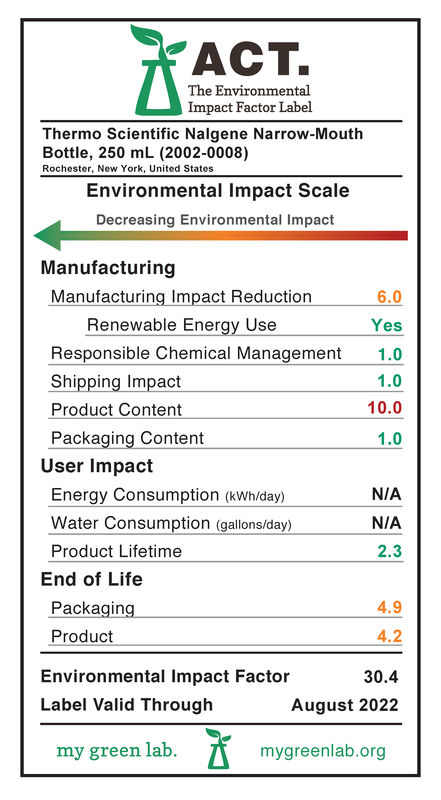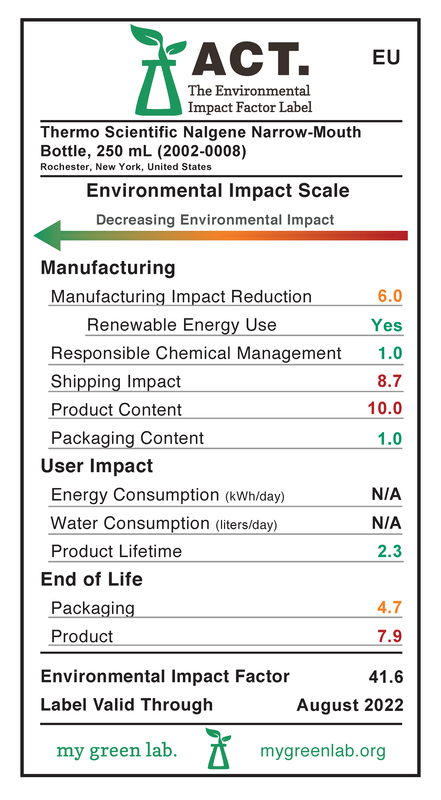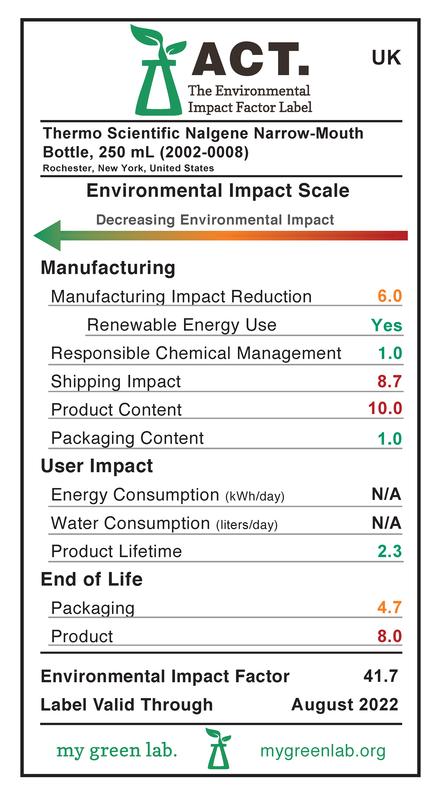Thermo Scientific Nalgene Narrow-Mouth Bottle, 250 mL (2002-0008) US/EU/UK
Additional Information about Thermo Scientific Nalgene Narrow-Mouth Bottle, 250 mL (2002-0008) US/EU/UK
Manufacturing Impact Reduction
This category evaluates the steps that Thermo Scientific has taken to reduce energy consumption, water consumption, and/or waste generation at the manufacturing facility at which the Thermo Scientific Nalgene Bottle is made. The score of 6 in this category reflects Thermo Scientific's efforts to reduce energy consumption at the facility.
Renewable Energy Use
The Rochester, NY manufacturing facility which produces the Thermo Scientific HDPE bottles participates in a program through which they are able to purchase hydro-electric renewable energy.
Responsible Chemical Management
The score of 1 in this category reflects proof of an Environmental Health and Safety program, and verification that the Thermo Scientific Nalgene bottles do not contain CMRs, PBTs, GHS Category 1 Hazards, GS BM-1 chemicals, GS LT-1 chemicals, or red list chemicals.
Shipping Impact
The Thermo Scientific Nalgene bottles are manufactured in Rochester, NY. The EU and UK markets are serviced via Thermo Fisher Scientific's distribution center in Eindhout, Belgium.
Product Content
The Thermo Scientific Nalgene Bottles do not contain any sustainable content.
Packaging Content
The cartons used to package Thermo Scientific Nalgene Bottles contain recycled content resulting in over 50% by weight of recycled content in the packaging materials overall.
Energy Consumption
Thermo Scientific Nalgene Bottles do not consume energy during their use phase.
Water Consumption
Thermo Scientific Nalgene Bottles do not consume water during their use phase.
Lifetime Rating
Thermo Scientific Nalgene Bottles have an estimated lifetime of 6 months to 5 years depending on their specific application.
Packaging End-of-Life
The Thermo Scientific Nalgene bottles packaging materials include corrugated cartons, paper inserts, and low-density polyethylene (LDPE) bags. The paper and cardboard packaging materials are readily recyclable in the US, EU and UK markets. In the US, the LDPE bag are recyclable but the infrastructure is not readily available. In the EU and UK, the LDPE bags are either sent to a waste-to-energy facility or are recycled, depending on the specific market. Further, Thermo Scientific provides its customers with instructions on how to properly dispose of the packaging materials at their end-of-life.
Product End-of-Life
The Thermo Scientific Nalgene bottles are made from high-density polyethylene (HDPE) and polypropylene (PP). In the US, the HDPE is readily recyclable while the PP is recyclable but the infrastructure is not readily available. In the EU and UK, the plastic materials are either sent to a waste-to-energy facility or are recycled, depending on the specific market. Further, Thermo Scientific provides its customers with instructions on how to properly dispose of the packaging materials at their end-of-life.
This category evaluates the steps that Thermo Scientific has taken to reduce energy consumption, water consumption, and/or waste generation at the manufacturing facility at which the Thermo Scientific Nalgene Bottle is made. The score of 6 in this category reflects Thermo Scientific's efforts to reduce energy consumption at the facility.
Renewable Energy Use
The Rochester, NY manufacturing facility which produces the Thermo Scientific HDPE bottles participates in a program through which they are able to purchase hydro-electric renewable energy.
Responsible Chemical Management
The score of 1 in this category reflects proof of an Environmental Health and Safety program, and verification that the Thermo Scientific Nalgene bottles do not contain CMRs, PBTs, GHS Category 1 Hazards, GS BM-1 chemicals, GS LT-1 chemicals, or red list chemicals.
Shipping Impact
The Thermo Scientific Nalgene bottles are manufactured in Rochester, NY. The EU and UK markets are serviced via Thermo Fisher Scientific's distribution center in Eindhout, Belgium.
Product Content
The Thermo Scientific Nalgene Bottles do not contain any sustainable content.
Packaging Content
The cartons used to package Thermo Scientific Nalgene Bottles contain recycled content resulting in over 50% by weight of recycled content in the packaging materials overall.
Energy Consumption
Thermo Scientific Nalgene Bottles do not consume energy during their use phase.
Water Consumption
Thermo Scientific Nalgene Bottles do not consume water during their use phase.
Lifetime Rating
Thermo Scientific Nalgene Bottles have an estimated lifetime of 6 months to 5 years depending on their specific application.
Packaging End-of-Life
The Thermo Scientific Nalgene bottles packaging materials include corrugated cartons, paper inserts, and low-density polyethylene (LDPE) bags. The paper and cardboard packaging materials are readily recyclable in the US, EU and UK markets. In the US, the LDPE bag are recyclable but the infrastructure is not readily available. In the EU and UK, the LDPE bags are either sent to a waste-to-energy facility or are recycled, depending on the specific market. Further, Thermo Scientific provides its customers with instructions on how to properly dispose of the packaging materials at their end-of-life.
Product End-of-Life
The Thermo Scientific Nalgene bottles are made from high-density polyethylene (HDPE) and polypropylene (PP). In the US, the HDPE is readily recyclable while the PP is recyclable but the infrastructure is not readily available. In the EU and UK, the plastic materials are either sent to a waste-to-energy facility or are recycled, depending on the specific market. Further, Thermo Scientific provides its customers with instructions on how to properly dispose of the packaging materials at their end-of-life.



